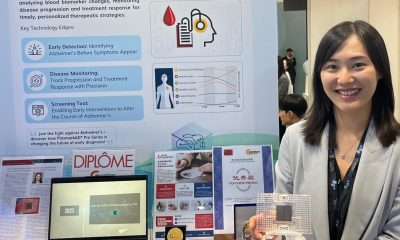Research
Radiofrequency technology treatment can clear brain toxins while awake

A new paper has presented clinical studies that show how treating the brain while it is awake with radiofrequency wave treatment can induce brain cleansing that is normally achieved with sleep.
The bioengineered radiofrequency technology has the potential to counter the effects of insomnia and sleep deprivation on brain toxin cleansing, and to reduce the amount of sleep normally required for brain toxin cleansing.
“An ability to safely induce brain cleansing during wakefulness is important because of the reduced sleep and sleep disturbances that occur during ageing and in multiple brain disorders of ageing such as Alzheimer’s Disease and Parkinson’s Disease,” said Dr. Gary Arendash, author of the paper and principal at RF Longevity.
In clinical studies performed at the University of South Florida, Alzheimer’s patients were given daily radiofrequency wave treatment during wakefulness at home by their caregivers. Both blood and brain levels of the toxins beta-amyloid and tau were measured at several months and one to two years into treatment.
Radiofrequency wave treatment resulted in a substantial increase in toxin drainage from the brain and into blood of the Alzheimer’s patients.
“It appears that radiofrequency wave treatment increases the natural flow of fluid out of the brain through meningeal lymphatic vessels” explained Dr. Arendash.
“Acting as sinks, these lymphatic vessels normally carry around 50 per cent of toxins and metabolic wastes out of the brain during sleep, but their flow is decreased in normal aging and Alzheimer’s Disease.”
Lack of sleep and sleep disturbances contribute to accumulation of the toxins beta-amyloid and tau in the brain, leading to Alzheimer’s Disease. In the treated Alzheimer’s patients, cognitive impairment was stopped and even reversed by one-hour radiofrequency wave treatments to the entire brain during wakefulness.
“We are excited by the implications of these clinical findings, which appear to be the first to provide biomarker evidence of increased brain cleansing by any human clinical intervention” said Dr. Arendash.
He emphasised the importance of additional clinical trials with this bioengineered technology in both normal humans and those with neurologic disorders of ageing to determine the technology’s full potential for human brain cleansing.
Wellness
Scientists discover new anti-ageing drug class that could extend lifespan

Scientists have identified a new anti-ageing drug class that acts on gut bacteria processes, offering potential new ways to extend human lifespan.
The drugs target the Target of Rapamycin (TOR) pathway — a system in humans and other species that regulates growth and ageing and plays a central role in age-related diseases such as cancer and dementia.
The discovery helps explain how drugs can influence longevity through this pathway, which is already a major focus in ageing and cancer research.
Existing drugs such as rapamycin have shown promise in extending healthy lifespan in animals.
Researchers from Queen Mary University of London tested a next-generation drug called Rapalink-1, which inhibits TOR and is being investigated for its anti-cancer properties.
They found that Rapalink-1 not only slowed yeast cell growth but also extended lifespan, acting through the TORC1 cluster of proteins — part of the growth-promoting arm of the TOR pathway.
The study also identified a key role for gut bacteria enzymes known as agmatinases, which break down agmatine — a compound produced from the amino acid arginine — and help keep TOR activity in check.
Previous research has shown that when these enzymes lose function, cells grow faster and age prematurely.
Studies have also indicated that compounds linked to this pathway can promote longevity and benefit cells.
“By showing that agmatinases are essential for healthy ageing, we’ve uncovered a new layer of metabolic control over TOR – one that may be conserved in humans,” said Charalampos Rallis, an author of the study.
“Because agmatine is produced by diet and gut microbes, this work may help explain how nutrition and the microbiome influence ageing.”
Although agmatine supplements are already available commercially, scientists caution against taking them for growth or longevity without medical supervision.
The research suggests agmatine may be beneficial only when certain metabolic pathways related to arginine breakdown are functioning properly.
“In addition, agmatine does not always promote beneficial effects as it can contribute to certain pathologies,” Dr Rallis said.
News
Half of Brits fear dementia more than any other condition, research finds

Half of UK adults fear dementia more than any other health condition, with women and over-65s the most likely to share this concern, new research shows.
The figures come from the latest Dementia Attitudes Monitor, a biennial survey of more than 2,000 people that tracks how the public thinks and feels about dementia.
It explores what people believe raises their risk, how likely they are to seek a diagnosis, and their views on how effective treatments are.
Now in its fourth wave since launching in 2018, the survey was commissioned by Alzheimer’s Research UK and shows that fear remains high as dementia continues to be the UK’s leading cause of death.
Hilary Evans-Newton is chief executive of Alzheimer’s Research UK.
She said: “People fear dementia because there is still no cure. Dementia continues to rob people of their independence and place an immense strain on families and society.
“By 2040, 1.4 million people in the UK are expected to be living with dementia, making progress more urgent than ever.”
While 59 per cent of UK adults say they would feel comfortable discussing a diagnosis, stigma remains a major barrier, particularly among minority ethnic communities.
Among Black African, Black Caribbean and Black British adults, this drops to 46 per cent, with more than a third (35 per cent) saying they would not feel comfortable — compared with 23 per cent of white respondents.
Views also vary by age.
Nine in ten people aged 35–64 said they would likely seek a diagnosis if they were worried about early-stage Alzheimer’s or another form of dementia.
Among adults aged 65 and over, this falls slightly to eight in ten.
Older adults are twice as likely to say they wouldn’t seek a diagnosis: seven per cent of those aged 35–64 said they probably wouldn’t speak to a doctor, compared with 14 per cent of people aged 65 and over.
Alzheimer’s Research UK is tackling stigma through its Dementia Community Champions programme, which supports volunteers to start conversations about dementia, stigma and research within their own communities.
Emily Allen, a supporter of the charity whose mother was diagnosed with young-onset Alzheimer’s in 2010, shared her experience.
She said: “When mum was first diagnosed, I didn’t know much about dementia.
“I remember searching the internet for any information I could find about Alzheimer’s.
“I couldn’t comprehend the thought of mum not knowing my name, not knowing who I am. It was terrifying.
“When I discussed it with my sisters, we would call it the ‘Big A’ as we couldn’t bring ourselves to say the word.
“I think there is more understanding among the public about dementia now.
“But there is still so much fear because of how it affects people and their families, and because there are so few effective treatments available.”
When asked to choose the top priorities for dementia research from a list of eight, 43 per cent of respondents selected finding a cure as the most or second-most important goal, followed closely by prevention.
Since the previous wave of the monitor in 2023, two new treatments — lecanemab and donanemab — have been licensed in the UK (2024).
Although not yet available on the NHS, they mark a significant milestone in research and may explain why the public continues to prioritise a cure.
Insights
Weight loss jabs could make cancer scans less effective, study suggests

Weight loss jabs such as Mounjaro and Wegovy could make some cancer scans less effective, leading to unnecessary tests and possible delays in treatment, experts suggest.
The drugs, collectively known as GLP-1s, have helped millions lose up to a fifth of their body weight but may alter how tissue appears on PET-CT scans used to diagnose and stage cancers.
The changes could cause healthy tissue to be misinterpreted as potentially cancerous, meaning some patients may face extra investigations and anxiety while awaiting results.
British researchers at Alliance Medical, a leading provider of diagnostic imaging in the UK, identified the issue after noticing unusual patterns in patient scans.
PET-CT scans combine CT and PET imaging, using a mildly radioactive liquid called a tracer to highlight areas where cells are more active than normal. Brighter spots can indicate cancer, though they may also reflect infections or inflammation.
“We noticed unusual uptake in one of our patients on a GLP-1 agonist, which prompted a wider review across our network,” said Dr Peter Strouhal, medical director at Alliance Medical and lead author of the study.
“We found that these altered patterns are increasingly common, yet there is currently no national or international guidance in the UK addressing this emerging issue.”
The review of several PET-CT scans found atypical tracer patterns among GLP-1 users that “could be misinterpreted” as hot spots or potentially cancerous areas.
“Recognising the characteristic uptake associated with GLP-1 agonists helps avoid unnecessary anxiety and interventions, ensuring patients receive the right care, at the right time, without detours or doubt,” Dr Strouhal said.
Researchers said larger studies involving more data are needed before recommendations can be made to change PET-CT scan guidelines for weight loss jab users.
They advised clinicians to consider a patient’s medical history when interpreting results.
It follows earlier US research suggesting GLP-1 drugs could interfere with breast-cancer chemotherapy medicines.
That study tracked hundreds of women with early-stage triple-negative breast cancer during and after treatment.
Twenty-five were already taking GLP-1s alongside other diabetes drugs and continued doing so while undergoing chemotherapy.
Two years later, 28 per cent of the women on GLP-1s had fully responded to treatment and were clear of cancer, compared with 63 per cent of those not using the drugs.
Researchers also found GLP-1s had entered tumour and immune cells in tissue samples from the patients.
“Use of GLP-1 use may need to be carefully considered during breast cancer therapy,” said Dr Bethania Santos, oncologist and researcher at UT Southwestern Medical Center in Dallas, who presented the study at the San Antonio Breast Cancer Symposium.
However, experts at the time said the drugs themselves may not have reduced the effectiveness of chemotherapy.
People with advanced diabetes who require several medicines already have a higher risk of breast-cancer recurrence.
The study did not prove whether weight-loss drugs help or hinder the success of cancer therapy.

 News1 month ago
News1 month agoHep B vaccine may lower diabetes risk, study suggests

 News2 weeks ago
News2 weeks agoSimple test can predict risk of severe liver disease

 Insights2 months ago
Insights2 months agoInterview: How AI-driven blood test could speed Alzheimer’s diagnosis

 News1 month ago
News1 month agoOdds of dementia strongly linked to number of co-existing mental illnesses, study finds

 Insights4 days ago
Insights4 days agoWeight loss jabs could make cancer scans less effective, study suggests

 Research2 months ago
Research2 months agoLong Covid causes effects similar to Parkinson’s or stroke, research reveals

 Wellness3 weeks ago
Wellness3 weeks agoExercise may lower dementia risk, study suggests

 News1 month ago
News1 month agoSweeteners could age the brain by 1.6 years, research suggests





































